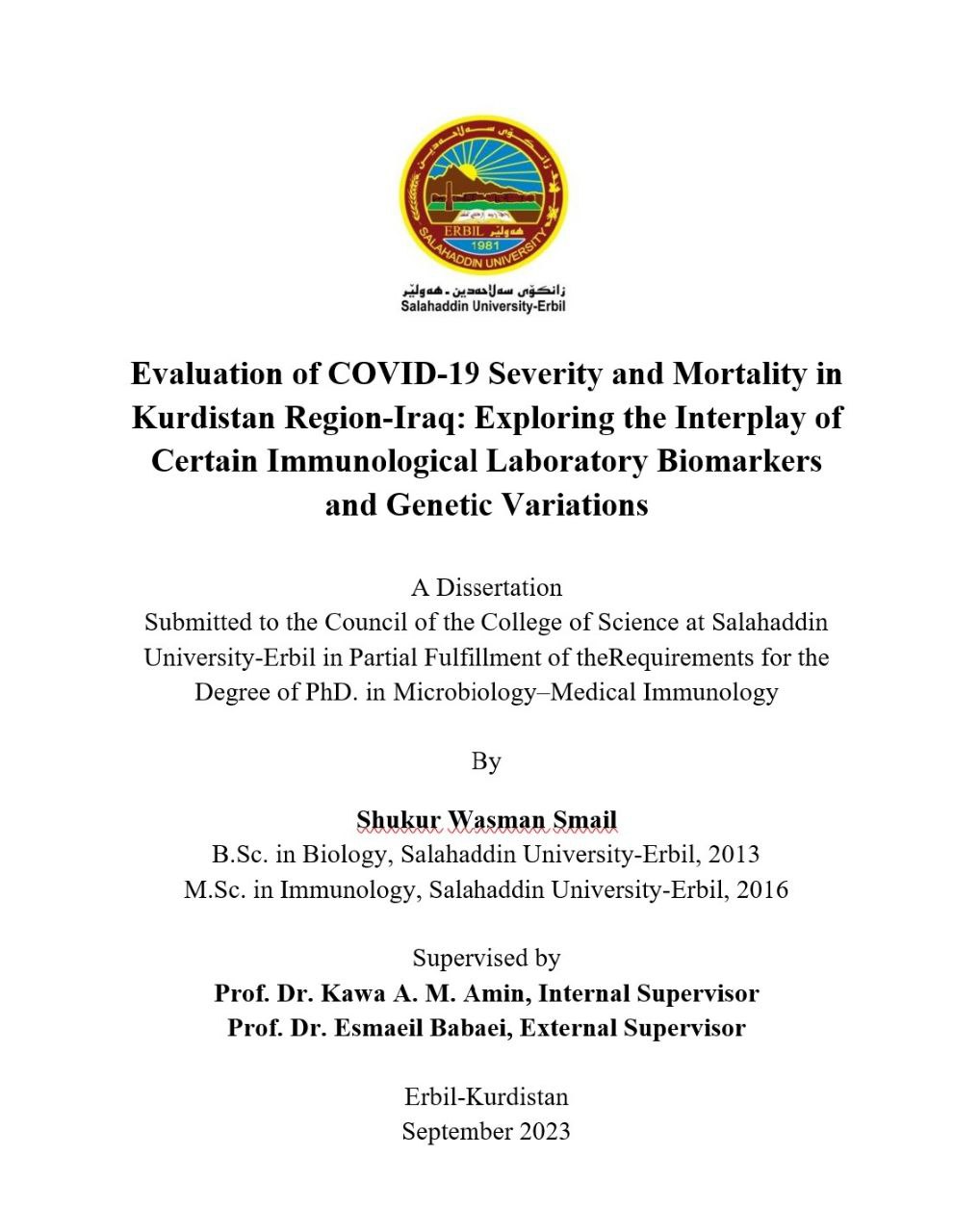SUMMARY
Coronavirus disease-2019 (COVID-19), which is caused by severe acute respiratory syndrome-coronavirus-2 (SARS-CoV-2), is a devastating pandemic-causing disease. This dissertation aims to predict susceptibility, severity, and mortality of COVID-19 based on demographic, clinical, cytokines, chemokines, routine laboratory biomarkers, cyclic threshold (Ct) value (viral load) of real-time polymerase chain reaction (RT-PCR), and variants of the genes among Kurdish population. This observational cohort-study comprises 200 COVID-19 patients (115 males/ 85 females) with a median age of 45 (35-52) and 100 healthy controls (HCs) (50 males/ 50 females) with a median age of 39 (30-49.5). The COVID-19 participants were recruited from various cities in the Kurdistan Region–Iraq from May to November 2021. Following admission to the hospital, blood was directly collected. This dissertation is divided into four projects based on four papers that were published in it.
In project Ⅰ, 180 patients with COVID-19 and 90 HCs participated in this study. Patients were divided into three different subgroups based on disease severity: mild (n=81), severe (n=60), and critical groups (n=39). Cytokines, chemokines, and other routine laboratory markers were measured. Compared to HCs, a significant increase in interleukin (IL)-23, IL-10, tumor necrosis factor-alpha (TNF-α), monocyte chemoattractant protein-1 (MCP-1), neutrophils, and neutrophil-to-lymphocyte ratio (NLR) was observed in all groups of COVID-19 patients. Regarding body mass index (BMI), C-reactive protein (CRP), and IL-17, significant increases were found in the severe and critical groups but not in the mild group compared with HCs. Furthermore, lymphocytes experienced a significant decrease in mild and severe COVID-19 groups compared to the HCs. In addition, non-significant changes were found in serum myeloperoxidase (MPO) and chemokine ligand 3 (CCL3) among the studied groups.
Project Ⅱ included 153 COVID-19 patients and 50 HCs; the patients were re-grouped into survivors (n=105) and non-survivors (n=48). Laboratory markers and single nucleotide polymorphisms (SNPs) in the genes (angiotensin-converting enzyme 2 (ACE2), transmembrane serine protease 2 (TMPRSS2), TNF-α and interferon-gamma (IFN-γ)) were all evaluated. Age over 40 and comorbidities were risk factors for mortality. Moreover, the best performances in predicting mortality were IFN-γ, NLR, and TNF-α. AA genotype and allele A of TMPRSS2 (rs2070788) decreased while GA genotype and allele A of TNF-α (rs1800629) increased susceptibility to COVID-19. The patients carrying the GA genotype of TNF-α (rs1800629) had shorter survival time (9.864 days) than those carrying the GG genotype (18.27 days) with plog-rank <0.0001. The genotype GA increased mortality rates by up to 3.8 folds and was associated with high production of serum TNF-α. Regarding IFN-γ (rs2430561), the survival rate for COVID-19 patients carrying the TT genotype (58.54%) was lower than those carrying TA and AA genotypes (80.28%); the TT genotype increased the risk of death (Hazard ratio (HR) = 3.664, p-value <0.0001) and was linked significantly to high serum IFN-γ production.
Concerning project Ⅲ, it comprised 120 COVID-19 patients and 60 HCs (n = 60). The patients were re-categorized into mild (n = 54), severe (n = 40), and critical (n = 26) groups. Demographic, routine laboratory, and oxidative stress (OS) biomarkers were investigated. NLR was higher in the critical group while lymphocytes were lower in the severe and critical groups compared to the mild group. CRP, ferritin, and D-dimer values were more elevated in severe and critical cases than in mild COVID-19 cases. The levels of malondialdehyde (MDA), nitric oxide (NO), and copper were elevated while the superoxide dismutase (SOD) activity level and total antioxidant capacity (TAC) level were lower. However, vitamin C, glutathione peroxidase (GPx), and catalase (CAT) activity levels did not change in the COVID-19 groups compared to the HCs. NO and ferritin were predictors of intensive care unit (ICU) hospitalization; D-dimer, MDA, and NLR were predictors of mortality. NO and NLR were predictors of oxygen saturation (SpO2) depression. Moreover, NO and copper both have good diagnostic values, their cutoffs were 39.01 and 11.93, respectively.
Project Ⅳ included 120 COVID-19 patients, of which 54 were mild, 40 were severe and 26 were critical. CRP, D-dimer, RT-PCR Ct value, and IL-18 (rs1946518) polymorphism by tetra-primers amplification refractory mutation system (T-ARMS)-PCR were evaluated. Low Ct was associated with SpO2 dropping, olfactory dysfunction (OD) and gustatory dysfunction (GD). IL-18 (rs1946518) polymorphism did not show any association with COVID-19 mortality.
In conclusion, IL-10, IL-23 and TNF-α were strongly linked to mortality in COVID-19 patients. Age, BMI, D-dimer, comorbidities, IFN-γ, NLR, NO and TNF-α were risk factors for death. NO and copper can be used for the diagnosis of COVID-19. TMPRSS2 (rs2070788) and TNF-α (rs1800629) altered susceptibility to SARS-CoV-2 infection. While TNF-α (rs1800629) and IFN-γ (rs2430561) were associated with COVID-19 mortality, IL-18 (rs1946518) did not illustrate any association with mortality. Additionally, low Ct value was associated with chemosensory dysfunctions, COVID-19 severity, and mortality.


